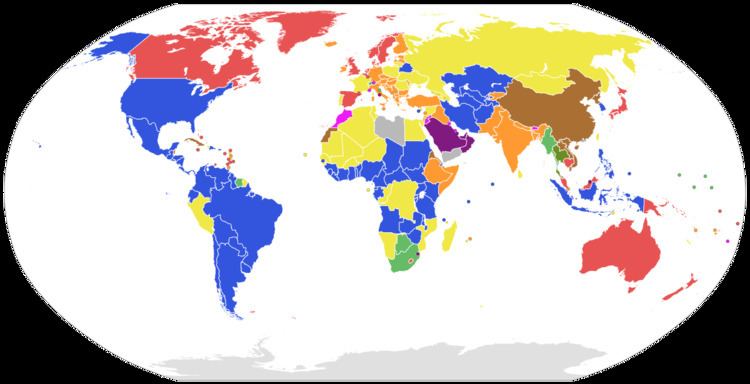 | ||
This is a list of the countries by system of government. There is also a political map of the world that shows what form of government each country has, as well as a brief description of what each form of government entails.
Contents
- UN member states and observers
- Other states
- Legend
- Systems of governance
- Presidential republics
- Full presidential systems
- Semiseparated presidential systems
- Parliamentary republics
- Mixed republican systems
- Directorial systems
- Constitutional monarchies
- Constitutional monarchies with ceremonial monarchs
- Constitutional monarchies with active monarchs
- Absolute monarchies
- Theocracies
- One party states
- Military junta states
- Transitional
- Federal
- Regionalized unitary
- European Union
- References
UN member states and observers
Note that Afghanistan, Iran, Pakistan and Mauritania are Islamic Republics.
Other states
The following states control their territory and are recognised by at least one UN member state.
The following states/governments control their territory, but are not recognised by any UN member states.
Legend
Note: this chart represent de jure systems of government, not the de facto degree of democracy. Several states constitutionally republics, broadly appear as authoritarian states.
Systems of governance
Italics indicate states with limited recognition.
Presidential republics
These are systems in which a president is the active head of the executive branch of government and is elected and remains in office independently of the legislature. The following list includes democratic and non-democratic states:
Full presidential systems
In full presidential systems, the president is both head of state and head of government. There is generally no prime minister, although if one exists he or she serves purely at the discretion of the president.
Presidential systems
Presidential systems with a non-executive prime minister
Semi(separated)-presidential systems
In semi-presidential systems, there is always both a president and a prime minister. In such systems, the president has genuine executive authority, unlike in a parliamentary republic, but the role of a head of government may be exercised by the prime minister.
Parliamentary republics
A parliamentary republic is a system in which a prime minister is the active head of the executive branch of government and also leader of the legislature. The president's degree of executive power may range from being reasonably significant (e.g. Pakistan) to little (e.g. India) or none at all (e.g. Ireland). Where the president holds little executive power, his or her function is primarily that of a symbolic figurehead.
Mixed republican systems
A combined head of state and government is elected by the legislature, however they are not subject to parliamentary confidence during their term (although their cabinet may be); the exceptions are in South Africa, where the President may be forced to resign by the Parliament's will, and also in Kiribati, where a successful parliamentary motion of no confidence automatically triggers a new presidential election.
Directorial systems
In the directorial system a council jointly exercises both state functions and governmental powers (the council is the collective head of state and government). The council is elected by the parliament, but it is not subject to political confidence during its term which has a fixed duration.
Constitutional monarchies
These are systems in which the head of state is a constitutional monarch; the existence of their office and their ability to exercise their authority is established and restrained or held back by constitutional law.
Constitutional monarchies with ceremonial monarchs
Systems in which a prime minister is the active head of the executive branch of government. In some cases the prime minister is also leader of the legislature, in other cases the executive branch is clearly separated from legislature although the entire cabinet or individual ministers must step down in the case of a vote of no confidence. The head of state is a constitutional monarch who normally only exercises his or her powers with the consent of the government, the people or their representatives.
Constitutional monarchies with active monarchs
The prime minister is the nation's active executive, but the monarch still has considerable political powers that can be used at their own discretion.
Absolute monarchies
Specifically, monarchies in which the monarch's exercise of power is unconstrained by any substantive constitutional law.
Theocracies
States based on a state religion where the head of state is selected by some form of religious hierarchy.
One-party states
States in which political power is by law concentrated within one political party whose operations are largely fused with the government hierarchy (as opposed to states where the law establishes a multi-party system but this fusion is not achieved anyway through electoral fraud or simple inertia). However, some do have elected governments.
Military junta states
The nation's military control the organs of government and all high-ranking political executives are also members of the military hierarchy.
Transitional
States which have a system of government which is in transition or turmoil and are classified with the current direction of change.
Federal
States in which the federal government shares power with semi-independent regional governments. The central government may or may not be (in theory) a creation of the regional governments; prime examples are India and the United States.
Regionalized unitary
States in which the central government has delegated some of its powers to regional authorities.
European Union
The exact political character of the European Union is debated, some arguing that it is sui generis (unique), but others arguing that it has features of a federation or a confederation. It has elements of intergovernmentalism, with the European Council acting as its collective "president", and also elements of supranationalism, with the European Commission acting as its executive and bureaucracy. But it is not easily placed in any of the above categories.
